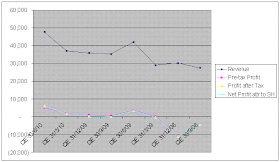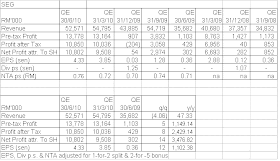Petronas Gas Bhd ('Petgas') Petgas is involved in the gas business value chain, providing gas processing and transmission services to PETRONAS through two of its divisions. The Plant Operations Division (POD) handles all activities pertaining to the processing of feed gas whilst the Transmission Operations Division (TOD) is responsible for the transmission and delivery of sales gas to end customers throughout the peninsula. It also delivers sales gas to customers in East Malaysia through a 45km pipeline in Sarawak. In addition to the throughput services business, it has also diversified into manufacturing, supplying and marketing of industrial utility products to the Kertih Integrated Petrochemical Complex and Gebeng Industrial Area through our Centralized Utility Facilities (CUF) Division.
Recent Development
Petgas appears to be benefiting from a new Gas Processing & Transmission Agreement ('GATP') starting from 1 April 2010 to 31 March 2014. To be frank, I can't see the difference between the previous agreement (here) and the new one (here). However, I believe it has a very positive effect on Petgas's last quarter results where the turnover was marginally higher but the profit margin spiked up substantially. See Chart 1 below.

Chart 1: Patgas's profit margin for the last 16 quarterly results
Recent Financial Results
For QE30/6/2010, Petgas's net profit increased by 90% q-o-q or 42% y-o-y to RM383 million while turnover increased by 9% q-o-q or 11% y-o-y to RM873 million.

Table: Petgas's 8 quarterly results

Chart 2: Petgas's last 16 quarterly results
Valuation
Petgas (closed at RM10.40 last Friday) is now trading at a current PER of 13.4 times (based on annualized EPS of 77.4 sen). Assuming a PER of 15 times, Petgas should have a fair value of RM11.61. It dividend yield is reasonable at 4.8%.
Technical Outlook
Petgas is in an uptrend line with support at RM9.70-9.80. Its next horizontal resistance is RM10.50 & then RM12.00.

Chart 3: Petgas's monthly chart as at Aug 22, 2010_log scale (Source: Tradesignum)
Conclusion
Based on improved financial performance, attractive valuation & positive technical outlook, Petgas could be a good stock for long-term investment.














































